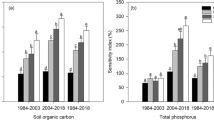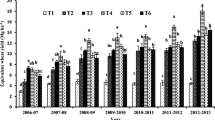Abstract
Huang-Huai-Hai (HHH) plains of China account for 69.2 % of annual wheat (Triticum aestivum) and 35.3 % of annual maize (Zea mays) production in China, and are China’s principal crop production area. Thus, the understanding of crop yield response to increase in soil organic carbon (SOC) stock in different fertilizer managements, soil types, and the threshold of SOC stock in the HHH region is the key factor affecting the adoption of fertilizer managements. Thus, data from ten long-term experiments have been collated and synthesized in this article. These long-term experiments involved four groups of similar fertilizer managements: (i) no chemical fertilizer or organic as control (CK), (ii) chemical nitrogen (N) fertilizer applied without organic manure (UF), (iii) combined application of chemical fertilizer (N, P, K) without organic manure (CF), and (iv) integrated nutrient management (INM) based on use of manure/straw and chemical fertilizer (N, P, K). The results indicated that (i) Crop yield increased with increase in SOC stock in all sites across the HHH. Increase in SOC stock by one Mg ha−1 increased crop yield (kg ha−1 year−1) from 66.9 in Changpin to 333.2 in XinjiA and 495.2 in XinjiB in sub-region 1, 1,031.4 in HengshuiA, 419.2 in HengshuiB, and 148.5 in Yucheng in sub-region 2, and 914.2 in ZhengzhouA, 1,116.6 in ZhengzhouB, 1,135.6 in Xuzhou, and 437.3 in Mengcheng in sub-region 3. (ii) The magnitude of increase in crop yield with increase in SOC stock varied among CK,UF,CF, and INM treatments for different sites across the HHH. A gradual but sustainable increase was observed through SOC-induced improvements in soil quality. (iii) The threshold value of SOC stock for sub-region 1 was 44.9 Mg ha−1 in XinjiA with the corresponding crop yield of 12.3 Mg ha−1 year−1. The available data were not sufficient to identify the threshold level of SOC stock for sub-region 2. The threshold values of SOC stock(Mg ha−1) for sub-region 3 were 27.5 in Xuzhou, and 44.6 in Mengcheng with the corresponding crop yield(Mg ha−1 year−1) of 14.5 and 10.5, respectively. (v)The threshold value of SOC stock in response to crop yield for the entire HHH ranged from 25.0 to 41.0 Mg ha−1, and the corresponding potential of increase in crop yield from 12.8 to 18.0 Mg ha−1 year−1. In comparison with a rapid yield response by application of chemical fertilizers, increase in SOC stock and improvement in soil quality result in a gradual but sustainable yield increase. Thus, restoration of the depleted SOC stock by conversion to a restorative land use and adoption of INM across the HHH can enhance soil quality and improve crop production.



Similar content being viewed by others
Abbreviations
- SOC:
-
Soil organic carbon
- HHH:
-
Huang-Huai-Hai plains
- C:
-
Carbon
- GHG:
-
Greenhouse gas
- CK:
-
Control treatment
- N:
-
Chemical nitrogen
- UF:
-
Chemical nitrogen (N) fertilizer applied without organic manure
- CF:
-
Combined application of chemical fertilizer (N, P, K) without organic manure
- INM:
-
Integrated nutrient management based on use of manure/straw and chemical fertilizer (N, P, K)
References
Benbi DK, Chand M (2007) Quantifying the effect of soil organic matter on indigenous soil N supply and wheat productivity in semiarid sub-tropical India. Nutr Cycl Agroecosyst 79:103–112
Cai ZC, Qin SW (2006) Dynamics of crop yields and soil organic carbon in a long-term fertilization experiment in the Huang-Huai-Hai Plain of China. Geoderma 136:708–715
Cui FJ (1997) The soil organic matter distribution in Fluventic Ustochrep soil. Soil Fertil 3:26–28 (in Chinese)
FAO (2009) Food security and Agricultural mitigation in developing countries; options for capturing synergies. FAO, Rome, 79
Farquharson RJ, Schwenke GD, Mullen JD (2003) Should we manage soil organic carbon in Vertisols in the northern grains region of Australia. Aust J Exp Agric 43:261–270
Ganzhara NF (1998) Humus, soil properties and yield. Eurasian Soil Sci 31:738–745
Gee GW, Bauder JW (1986) Particle-size analysis. In: Klute A (ed) Methods of soil analysis. American Society of Agronomy/Soil Science Society of America, Madison, pp 383–411
Gong W, Yan XY, Wang JY (2009) Long-term manuring and fertilization effects on soil organic carbon stocks under a wheat–maize cropping system in North China Plain. Plant Soil 314:67–76 (in Chinese)
Kong XB, Dao TH, Qin J, Qin H, Li C, Zhang F (2009) Effects of soil texture and land use interactions on organic carbon in soils in North China cities’ urban fringe. Geoderma 154:86–92
Kong XB, Lal R, Li BG, Liu HB et al (2014) Fertilizer intensification and its impacts in China’s HHH Plains. Adv Agron 125:135–169
Kukal SS, Rasool R, Benbi DK (2009) Soil organic carbon sequestration in relation to organic and inorganic fertilization in rice–wheat and maize–wheat systems. Soil Tillage Res 102:87–92
Lal R (2004) Soil carbon sequestration impacts on global climate change and food security. Science 304:1623–1627
Lal R (2010) Beyond Copenhagen: mitigating climate change and achieving food security through soil carbon sequestration. Food Secur 2:169–177
Li ZP, Lin XX, Che YP (2002) Analysis for the balance of organic carbon pools and their tendency in typical arable soils of eastern China. Acta Pedol Sin 39(3):353–354
Li ZP, Han FX, Sub Y, Zhang TL, Sun B, Monts DL, Plodinec MJ (2007) Assessment of soil organic and carbonate carbon storage in China. Geoderma 138:119–126
Lin ZA, Zhao BQ, Yuan L, Hwat BS (2009) Effects of organic manure and fertilizers long-term located application on soil fertility and crop yield. Sci Agric Sin 42(8):2809–2819 (in Chinese)
Liu SX, Mo XG, Lin ZH, Ji J, Wen G, Richey J (2010) Crop yield responses to climate change in the Huang-Huai-Hai Plain of China. Agric Water Manag 97:1195–1209
Lobell DB, Schlenker W, Costa RJ (2011) Climate trends and global crop production since 1980. Science 333(6042):616–620
Meng FQ, Wu WL, Xin DH (2000) The relationship between soil organic carbon change and crop yield in high productive soil. Plant Nutr Fertil 6(4):37–370 (in Chinese)
Pan GX, Smith P, Weinan P (2009) The role of soil organic matter in maintaining the productivity and yield stability of cereals in China. Agric Ecosyst Environ 129:344–348
Piao SL, Fang JY, Ciais P, Peylin P, Huang Y, Sitch S, Wang T (2009) The carbon balance of terrestrial ecosystems in China. Nature 458:1009–1010
Shanthi PV, Sreekanth NP, Babu P (2011) The trilemma of soil carbon degradation, climate change and food insecurity. Disaster Risk Vulnerablity Conference, Applied Geoinformatics for Society and Environment, Germany
Shi Y (2003) Comprehensive reclamation of salt-affected soils in China’s Huang-Huai-Hai plain. J Crop Prod 7(1–2):163–179
Smith MD (2011) An ecological perspective on extreme climatic events: a systemic definition and framework to guide future research. J Ecol 99:656–663
Soil Survey Staff (1999) Soil taxonomy, a basic system of soil classification for making and interpreting soil surveys. USDA natural resources conservation service agricultural handbook, 2nd edn. US Government Printing Office, Washington, p 436
Tiessen H, Moir JO (1993) Total and organic carbon. In: Carter MR (ed) Soil sampling and methods of analysis. Lewis Publishers, Boca Raton, pp 187–199
Wang SA (1994) The construction of high production cropland. China Agricultural University Press, Beijing (in Chinese)
Yan XY, Wei G (2010) The role of chemical and organic fertilizers on yield, yield variability and carbon sequestration— results of a 19-year experiment. Plant Soil 331:471–480 (in Chinese)
Zhang AJ, Zhang MP (2001) Organic and inorganic fertilizer affecting the content and composition of soil organic matter—a report of long-term experiment(in Chinese). Jianssu Agric Res 22(3):30–33
Zheng CL, Li KJ, Ma JY, Cao CY, Liu RX (2007) Effect of long-term allocated straw and chemical fertilizer application on winter wheat yield and spike characters. J Hebei Agric Sci 11(3):66–68 (in Chinese)
Acknowledgments
This work was supported by Special Fund for National Land Resource-scientific Research from National Ministry of Land and Resources, China (201011006-3).
Author information
Authors and Affiliations
Corresponding author
Rights and permissions
About this article
Cite this article
Kong, X., Lal, R., Li, B. et al. Crop Yield Response to Soil Organic Carbon Stock over Long-Term Fertilizer Management in Huang-Huai-Hai Plains of China. Agric Res 3, 246–256 (2014). https://doi.org/10.1007/s40003-014-0118-6
Received:
Accepted:
Published:
Issue Date:
DOI: https://doi.org/10.1007/s40003-014-0118-6




